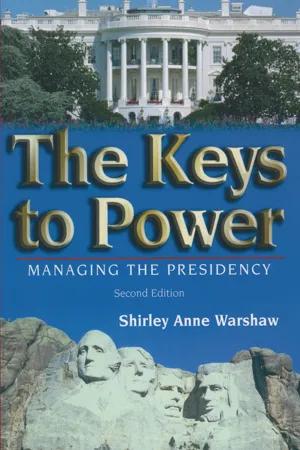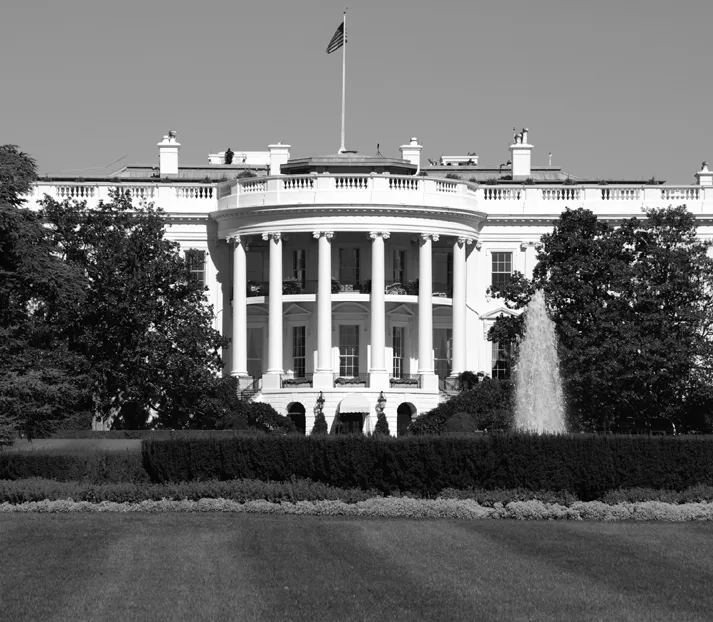![]()
As we examine the three branches of government in the United States, the executive branch is the most complicated and holds the most power. Neither the Congress nor the Supreme Court has the power to lead the country that the president, who heads the executive branch, has. The president has numerous advantages for exerting power within the national government, such as the power that ensues from having a national constituency and the power that ensues from having the wealth of knowledge and experience within the executive branch. Congress is limited by the constant confrontations within its 535-strong membership and by the often fractious relationship between the parties and between the houses, not to mention the comparatively small number of employees—30,000. The Supreme Court is limited by its mandate and by the workload of its nine members. The result is that both Congress and the Supreme Court are powerful institutions and essential within the structure of government for charting the course of public policy. Yet it is the president who plays the leadership role in the nation today for charting the nation’s public policy agenda and for moving that course for action toward fruition through the executive departments.
When we examine the powers of the presidency, we are focusing on both the constitutional powers bestowed on the president as well as the institutional advantages that the office of president has. The power of the presidency is a combination of the constitutional and institutional powers plus the enormous political power that the president has in the age of television. Only the president can command the attention of the media every day, day in and day out. No member of Congress and no member of the Supreme Court holds the interest of the American people in the same way that the president does.
Hardly a day goes by that the president is not on the front page of daily newspapers or in a lead story on the network evening news shows. Although Congress and the Supreme Court are essential to the balance of power and divided government, the president remains the dominant player in our structure of government. As the dominant player in this system of divided government, presidents must effectively utilize the tools available to them in order to manage the executive branch. The keys to power are found in the skillful use of the institutional, constitutional, and prerogative powers that are available to the president.
Qualifications for the Office of President
The qualifications for the office of president are fairly simple. One has to be a natural born citizen, at least 35 years of age, and a resident of the United States for at least 14 years before taking office. There is nothing complicated about having the requisite qualifications for holding the presidency. There are no thresholds for educational levels, no tests for serving as an elected official in some other capacity, and no requirement for having worked in Washington, D.C. The framers of the Constitution wanted to ensure that everyone would have the opportunity to run for president, regardless of their educational or economic background or their experience in government service.
The first point, that one has to be a natural born citizen, serves two purposes. On one hand, the framers did not want to take any chances that a loyalist to England and the monarchy would slip into the presidency and abandon many of the principles established in the Constitution. Although the Constitution would be in place, the framers were unsure that it could endure a president who could marshal public support for changing the nature of the presidency. On the other hand, the citizenship requirement mitigated any chance that the president would be from another foreign country and try to exercise control over foreign policy in a manner that was beneficial to the president’s “home country” and detrimental to the United States. There is a caveat to the requirement that the president be a natural born citizen, which is that the president must be a “citizen of the United States at the time of the Adoption of this Constitution” if not a natural born citizen. This caveat was added to allow Alexander Hamilton to qualify for the presidency, since he was born in the Caribbean Islands rather than in the United States. The term “natural born citizen” does not mean, however, that the president must be born within the borders of the United States. We interpret the phrase “natural born citizen” to mean that anyone seeking the office of president must have been born either within the borders of the United States or on United States military or diplomatic ground. Persons born on military bases abroad or within the embassies are considered “natural born” citizens.
TABLE 1.1 Qualifications for President | • Natural born citizen • 35 years of age • Resident of the United States for 14 years before taking office |
Finally, the Constitution requires that the president be a resident of the United States for 14 years, which ensures that anyone seeking the office of president must be knowledgeable about the nation and its people at the time. In today’s age of global television and international coverage in newspapers, this requirement would seem less important than it did in 1787. The media age has allowed citizens living abroad to have constant access to issues within the United States.
The requirement that the president be 35 years of age follows the natural progression that was placed in the Constitution for elected officials of the new nation. Members of the House of Representatives, which was considered the least important member of the decision process, were only required to be 25 years old, while members of the Senate had to be 30 years old, and the president had to be 35 years old. The president was seen by the framers as needing the most experience in decision-making and should be the most mature and the most experienced in such decisions.
Title
During the discussions on the presidency during the constitutional convention, Charles Pinckney proposed that the “Executive power be vested in a ‘President of the United States of America’ and his title shall be ‘His Excellency.’” As a result, when George Washington was elected president in 1789, the Congress, which had counted the votes of the electors, transmitted notification of his election with the phrase “To his Excellency, George Washington, Esq.” The letter read, “Sir: I have the honor to transmit to your Excellency the information of your unanimous election to the office of President of the United States.”1 Since the issue of title had never been resolved during the convention debates, the phrase that Pinckney used during the constitutional convention appeared to be the most logical.
The issue of title did not arise again until the first Congress was convened under the new constitution in the spring of 1789.2 The Senate and the House of Representatives established committees in April 1789 to study the issue of a formal title for the president. They agreed with Pinckney’s proposal on the term “His Excellency.” However, the full Senate disagreed with the phrase and convened another committee, which proposed the following language: “The Committee appointed to consider and report under what title it will be proper for the Senate to address the President of the United States of America reported that in the opinion of the Committee it will be proper thus to address him: ‘His Highness, the President of the United States of America and Protector of their Liberties.’” The full Senate again killed this terminology and suggested “the president be addressed ‘To the President of the United States,’” without addition of title. The full Senate approved this language through a resolution. The House of Representatives never commented on the title of the president after its initial committee meetings in April 1789. Subsequently the title “The President of the United States” is the title that the Senate has used by virtue of formal resolution and the House of Representatives has used by virtue of tradition. The public has followed these precedents as part of its tradition of shedding the aristocratic traditions of the British governmental structure.
Tenure
The tenure of the president is four years in office, with the opportunity to run for another four-year term. When the framers designed the Constitution, they struggled with the length of time the president should hold office. Should it be four years, six years, or seven years? Should the president have an unlimited number of terms? After a series of debates on the length of the term and on the number of terms the president should serve, the decision was to have a four-year term in office with an unlimited number of succeeding terms. There was a general sense in the constitutional convention that George Washington would be elected the nation’s first president. The framers did not want to limit the number of terms that Washington could serve, for they were convinced that Washington would provide strong leadership for the fledgling nation.
Washington was subsequently elected the nation’s first president but wanted to retire after one term. He reluctantly stayed for two terms because of impending foreign policy crises and at the urging of his cabinet officers. His second term proved to be a series of crises and constant attacks in the newspapers on his decisions. Newspapers in this era were particularly partisan and many of these partisan newspapers regularly chipped away at Washington’s once invincible public image. Washington retired after his second term.
Not a single president violated the precedent of serving two terms until the mid-1900s, when Franklin Delano Roosevelt was elected to four terms in office. Until President Roosevelt (1933–1945), every president had continued the tradition George Washington fostered and voluntarily limited their terms to eight years in office. With World War II dominating the national agenda, Roosevelt was easily elected to a third and then a fourth term.
There was some concern within Congress following Roosevelt’s unparalleled four terms in office that the Constitution should be amended to limit the number of terms in office to two terms. The issue was formally addressed in the Truman administration. Ratified by the states in 1951 during Truman’s presidency, the Twenty-Second Amendment to the Constitution limits the tenure in office for presidents to two terms. The amendment stated that “no person shall be elected to the office of the President more than twice.” While this seems to have settled the question, constitutional scholars are divided as to whether presidents are limited to two consecutive terms or to any two terms. If the amendment means only that the president is limited to two consecutive terms, then the door is open for a president to serve two terms and run again after four years out of office. This scenario has never been tested and probably will not be.
| No. | Name | Inaugurated | Dates in
Office | Terms
Served |
| 1. | George Washington | 1789 | 1789–1797 | Two |
| 2. | John Adams | 1797 | 1797–1801 | One |
| 3. | Thomas Jefferson | 1801 | 1801–1809 | Two |
| 4. | James Madison | 1809 | 1809–1817 | Two |
| 5. | James Monroe | 1817 | 1817–1825 | Two |
| 6. | John Quincy Adams | 1825 | 1825–1829 | One |
| 7. | Andrew Jackson | 1829 | 1829–1837 | Two |
| 8. | Martin Van Buren | 1837 | 1837–1841 | One |
| 9. | William Henry Harrison | 1841 | 1841–1841 | One—died in office |
| 10. | John Tyler | 1841 | 1841... |

